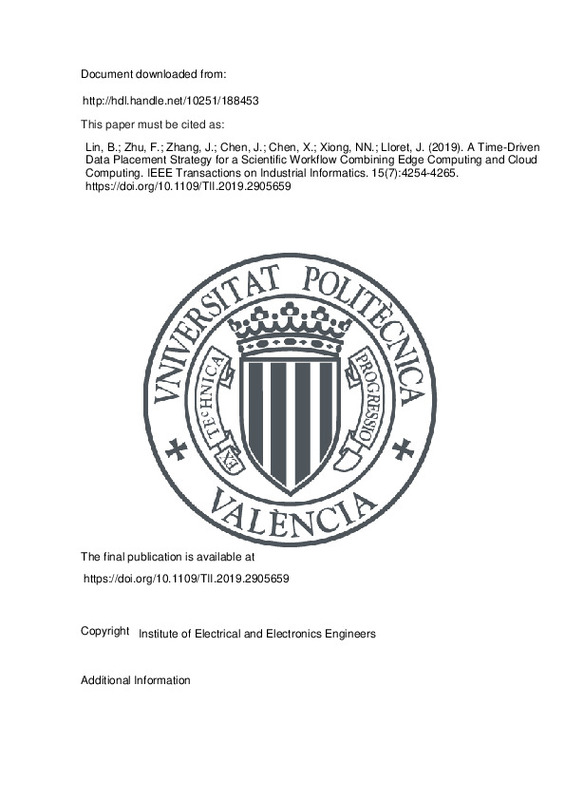JavaScript is disabled for your browser. Some features of this site may not work without it.
Buscar en RiuNet
Listar
Mi cuenta
Estadísticas
Ayuda RiuNet
Admin. UPV
A Time-Driven Data Placement Strategy for a Scientific Workflow Combining Edge Computing and Cloud Computing
Mostrar el registro sencillo del ítem
Ficheros en el ítem
| dc.contributor.author | Lin, Bing
|
es_ES |
| dc.contributor.author | Zhu, Fangning
|
es_ES |
| dc.contributor.author | Zhang, Jianshan
|
es_ES |
| dc.contributor.author | Chen, Jiaqing
|
es_ES |
| dc.contributor.author | Chen, Xing
|
es_ES |
| dc.contributor.author | Xiong, Naixue N.
|
es_ES |
| dc.contributor.author | Lloret, Jaime
|
es_ES |
| dc.date.accessioned | 2022-10-20T18:03:47Z | |
| dc.date.available | 2022-10-20T18:03:47Z | |
| dc.date.issued | 2019-07 | es_ES |
| dc.identifier.issn | 1551-3203 | es_ES |
| dc.identifier.uri | http://hdl.handle.net/10251/188453 | |
| dc.description.abstract | [EN] Compared to traditional distributed computing environments such as grids, cloud computing provides a more cost-effectiveway to deploy scientificworkflows. Each task of a scientific workflow requires several large datasets that are located in different datacenters, resulting in serious data transmission delays. Edge computing reduces the data transmission delays and supports the fixed storing manner for scientific workflow private datasets, but there is a bottleneck in its storage capacity. It is a challenge to combine the advantages of both edge computing and cloud computing to rationalize the data placement of scientific workflow, and optimize the data transmission time across different datacenters. In this study, a self-adaptive discrete particle swarm optimization algorithm with genetic algorithm operators (GA-DPSO) was proposed to optimize the data transmission time when placing data for a scientific workflow. This approach considered the characteristics of data placement combining edge computing and cloud computing. In addition, it considered the factors impacting transmission delay, such as the bandwidth between datacenters, the number of edge datacenters, and the storage capacity of edge datacenters. The crossover and mutation operators of the genetic algorithm were adopted to avoid the premature convergence of traditional particle swarm optimization algo-rithm, which enhanced the diversity of population evolution and effectively reduced the data transmission time. The experimental results show that the data placement strategy based on GA-DPSO can effectively reduce the data transmission time during workflow execution combining edge computing and cloud computing. | es_ES |
| dc.description.sponsorship | This work was supported in part by the National Key R&D Program of China under Grant 2018YFB1004800, in part by the Natural Science Foundation of Fujian Province under Grant 2019J01061386, in part by the Guiding Project of Fujian Province under Grant 2018H0017, in part by the Talent Program of Fujian Province for Distinguished Young Scholars in Higher Education, and in part by the Electronic Information and Control Open Fund of Fujian University Engineering Research Center under Grant MJXY-KF-EIC1802. Paper no. TII-19-0313. (Corresponding author: Xing Chen.) | es_ES |
| dc.language | Inglés | es_ES |
| dc.publisher | Institute of Electrical and Electronics Engineers | es_ES |
| dc.relation.ispartof | IEEE Transactions on Industrial Informatics | es_ES |
| dc.rights | Reserva de todos los derechos | es_ES |
| dc.subject | Cloud computing | es_ES |
| dc.subject | Data placement | es_ES |
| dc.subject | Data transmission time | es_ES |
| dc.subject | Edge computing | es_ES |
| dc.subject | Scientific workflow | es_ES |
| dc.subject.classification | INGENIERIA TELEMATICA | es_ES |
| dc.title | A Time-Driven Data Placement Strategy for a Scientific Workflow Combining Edge Computing and Cloud Computing | es_ES |
| dc.type | Artículo | es_ES |
| dc.identifier.doi | 10.1109/TII.2019.2905659 | es_ES |
| dc.relation.projectID | info:eu-repo/grantAgreement/NKRDPC//2018YFB1004800/ | es_ES |
| dc.relation.projectID | info:eu-repo/grantAgreement/Natural Science Foundation of Fujian Province//2019J01061386/ | es_ES |
| dc.relation.projectID | info:eu-repo/grantAgreement/Guiding Project of Fujian Province//2018H0017/ | es_ES |
| dc.relation.projectID | info:eu-repo/grantAgreement/FJUT//MJXY-KF-EIC1802/ | es_ES |
| dc.rights.accessRights | Abierto | es_ES |
| dc.contributor.affiliation | Universitat Politècnica de València. Departamento de Comunicaciones - Departament de Comunicacions | es_ES |
| dc.description.bibliographicCitation | Lin, B.; Zhu, F.; Zhang, J.; Chen, J.; Chen, X.; Xiong, NN.; Lloret, J. (2019). A Time-Driven Data Placement Strategy for a Scientific Workflow Combining Edge Computing and Cloud Computing. IEEE Transactions on Industrial Informatics. 15(7):4254-4265. https://doi.org/10.1109/TII.2019.2905659 | es_ES |
| dc.description.accrualMethod | S | es_ES |
| dc.relation.publisherversion | https://doi.org/10.1109/TII.2019.2905659 | es_ES |
| dc.description.upvformatpinicio | 4254 | es_ES |
| dc.description.upvformatpfin | 4265 | es_ES |
| dc.type.version | info:eu-repo/semantics/publishedVersion | es_ES |
| dc.description.volume | 15 | es_ES |
| dc.description.issue | 7 | es_ES |
| dc.relation.pasarela | S\473049 | es_ES |
| dc.contributor.funder | Fujian University of Technology | es_ES |
| dc.contributor.funder | Guiding Project of Fujian Province | es_ES |
| dc.contributor.funder | Natural Science Foundation of Fujian Province | es_ES |
| dc.contributor.funder | National Key Research and Development Program of China | es_ES |







![[Cerrado]](/themes/UPV/images/candado.png)

